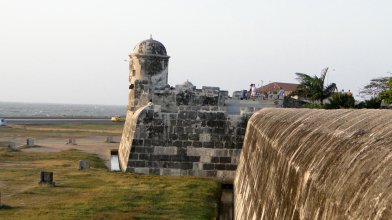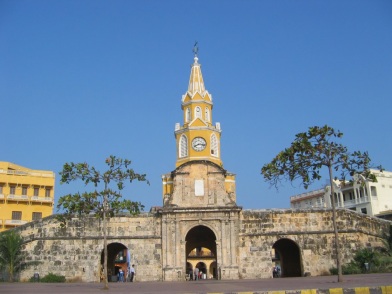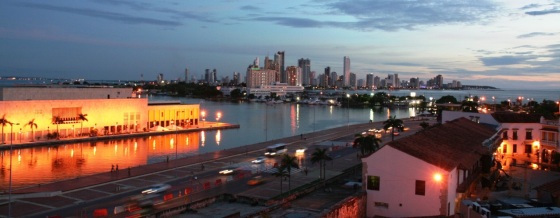Any time of the year is perfect to visit Cartagena de Indias and to be amazed by one of the world’s best kept secret. Do not worry about winter, spring or fall. Cartagena is summer year round. Its climate slightly varies by 10 degrees Fahrenheit throughout the year, from 80 to 90° F, and the Caribbean breeze intensifies in a delicious way when winter crashes the rest of the world. Even though Cartagena has no weather or touristic seasons, my recommended time of the year to visit this beautiful city is in January or February; New Year’s buzz has faded and not much tourists around, yet local people waiting to grace with your presence.
Let me show you a different spot in the world that might not be in your bucket list, but for sure, when getting there you’ll be planning your comeback trip with the whole family or friends. Here are some ideas.
 View of the walled sector. By: Google Images
View of the walled sector. By: Google Images
The Walled Old City, declared part of the UNESCO World Heritage in 1984, offers a treasure of colonial architectural gems, churches, and colors that make an incredible and memorable visit. There are also several museums and 400-year-old plazas.
 Clock Tower from outside. By: Google Images
Clock Tower from outside. By: Google Images
Hop on in a horse-drawn carriage and go around the walled sector to take a glimpse on what you’ll find inside the stone walls. Tell the driver to stop at la Torre del Reloj (Clock Tower), what was once the main entrance of the old Cartagena, now a republican style tower, with a quadrilateral clock.
 Horse-drawn carriage, inside the walled sector. By: Google Images.
Horse-drawn carriage, inside the walled sector. By: Google Images.
Continue your ride inside the walls trough the entrance next to the luxurious Charleston Santa Teresa Hotel, admire the colonial architecture and small plazas while you pass by. At the end of the narrow street you find the San Pedro Claver’s plaza.
 San Pedro Claver Cathedral from outside. By: Google Images.
San Pedro Claver Cathedral from outside. By: Google Images.
Get inside the Sanctuary of San Pedro Claver; built between 1580 and 1654, under the parameters of colonial buildings. It was originally known as Church of St. John of God, St. Ignatius of Loyola and now called San Pedro Claver, for his dedication to alleviate the suffering of the slaves of Cartagena de Indias. His remains are found in the high altar. After he was designated as a saint his femur had been taken to the Vatican in honor of what he was and did.
 View from San Pedro’s Bastion at night. By: Google Images
View from San Pedro’s Bastion at night. By: Google Images
Once you get outside the church, on your right, you’ll find a ramp next to the plaza. Climb it, and delight yourself with the astonishing view of the Muelle de los Pegasos (Pegasos Pier), the majestic Convention Center, and the never ending Caribbean ocean at Baluarte de San Pedro (San Pedro’s Bastion).
 La Catedral at night. By: Google Images
La Catedral at night. By: Google Images
Your 400 years of history are just starting; next stop is La Catedral (The Cathedral), is the episcopal of the Archbishop of Cartagena de Indias, one of the oldest episcopal in the Americas. In 1586, while the church was still under construction, it was attacked by the English pirate Francis Drake, causing severe damage and delayed its completion. Finished in 1612, now Famous because of the most incredible and luxurious weddings of, national personalities, locals and foreign.
 Colonial Houses inside the walled sector. By: Google Images
Colonial Houses inside the walled sector. By: Google Images
Don’t forget to have your camera ready, any corner, small balcony of the colonial houses, church or plaza are waiting for a shot.
 Las Bóvedas. By: Google Images.
Las Bóvedas. By: Google Images.
It’s time to get some souvenirs at Las Bóvedas. These construction of 23 chambers built between 1792 and 1796, is now days a building of 23 souvenir shops. This was one of the last major structure carried out in colonial times, destined for military purposes; used by the Spaniards as stockrooms for munitions and supplies. Later, during the republican era, they were turned into a prison.
When ready to purchase some colorful and typical handcrafts at this series of shops don’t forget to bargain, you’ll get to the right price with a little persuasion.
 San Felipe de Barajas Fort. By Google Images.
San Felipe de Barajas Fort. By Google Images.
Say goodbye to the horse carriage and grab a taxi. Tell the driver to take you to Castillo San Felipe de Barajas (San Felipe de Barajas Fort) some 5 minutes away. One of the oldest buildings in Colombia will appear as a huge and harmonious fortification. Cartagena was a port of slave trade; the Spanish built this castle during the colonial era to command the whole bay so any suspicious vessel trying to dock could be instantly attacked.
Its outstanding entrance with eight guns and a garrison of 20 soldiers and 4 gunners, sits in a complex labyrinth of tunnels connected through strategic points that allowed distribution of provisions and to facilitate evacuation and communication; with no doughty reflect the courage and wit of the Spaniard to defend Cartagena de Indias.
 View from San Felipe de Barajas Fort. By Google Images.
View from San Felipe de Barajas Fort. By Google Images.
Take a deep breath, you must be on top of this massive construction, breath again and open your eyes to the astonishing 360° view of the city.
 Convento La Popa. By: Google Images.
Convento La Popa. By: Google Images.
Continue in your taxi ride 1.5 miles to Convento de La Popa (The Convent of the Stern), the highest point in the city, and be ready for a zigzag trip up the hill. On its peak you will find a gorgeous colonial church and convent, built between 1609 and 1611. Slaves established in the city and surrounding had authorization to celebrate their festivities in this convent. The display of emotions and creativity resulted in one of Colombia’s most precious musical rhythm, the Cumbia.
 View From La Popa. By: Wikipedia.org
View From La Popa. By: Wikipedia.org
Breathe again, and get your camera ready. The highest point in Cartagena shows the most complete view of the city in only one shot.
Overwhelmed? History never gets old, but Cartagena has much more to offer.